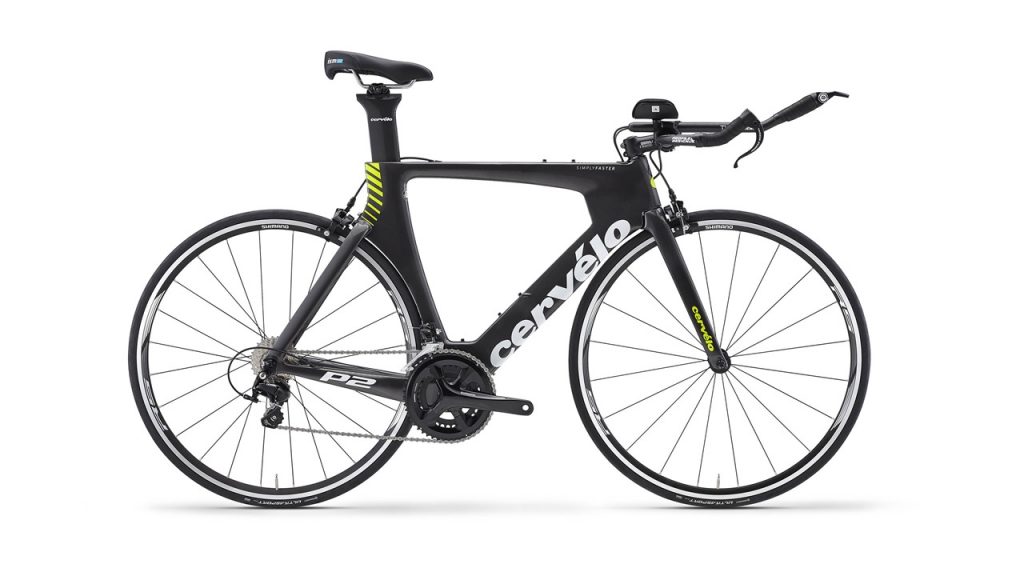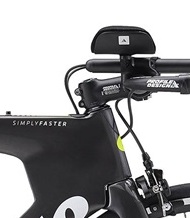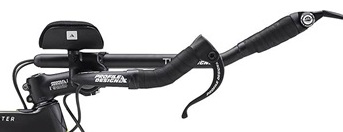2018 Cervelo P2 Review – Still A Leader After All These Years
Why write about the 2018 Cervelo P2, you ask? The P2 has been around forever, the frame hasn’t changed in a few seasons and you’ve written about it before. What is left to be said? Well, in one form or another, yes, the P2 has been around for quite a long time. My wife’s aluminum P2K (which she still loves) dates from 2004, and it is by no means the oldest P2 that we see coming into the shop for service. Cervelo started the P2 model back in 1996, as one of the very first truly aero tri bikes. The 2017 Kona Ironman Bike Count showed 570 Cervelos. The next highest manufacturer count was 261 bike. This tells you something about the role Cervelo has played in aero bike technology, doesn’t it? This tells you something about how relevant the P2 remains.
If you check the transition area of most any triathlon it will seem that half the bikes are Cervelo P2’s of one generation or another. There are good reasons for this. The Cervelo P2 has always offered a high level of aerodynamic performance, a comfortable ride, good quality components, and (outside of a seatpost design or two in the early generations) easy serviceability, at a bargain price.
2018 CERVELO P2 FRAME DESIGN
In 2014, Cervelo completely redesigned the P2 with a new frame and fork design. The 2018 model continues to use this frame, but with new graphics and updated specs. The bike still has the inset rear wheel that has been a hallmark of every P2 since the beginning. However, the latest generation P2 now shares a carbon fiber frame with its bigger brother too, the Cervelo P3, and has many of the same design elements of the Cervelo P5 and P5X superbikes, two of the fastest bikes on the planet. While the P2 may not have quite the “spaceship” look of some other recent entries in the tri bike market from other manufacturers, it is nonetheless aerodynamically very effective while lacking the sometimes gimmicky complexity of some other designs.
 Some recent entries into the tri market have pursued aerodynamics and drivetrain stiffness at the expense of ride quality. Vibrations and jarring ride are not your friend in an event where you are on the bike for a long-time and/or that you have to do another very physically demanding event following the bike. The Cervelo P2 does not make this compromise. While the P2 does not have the burly bottom bracket of the P5, it is far from wimpy. The bottom bracket area is reinforced and uses Cervelo’s proprietary BBRight design with oversized asymmetrical chainstays to make sure power is transferred efficiently for almost anyone. While the absolute most powerful and biggest riders may claim to want even more stiffness, it will be a very small number of people who would truly be looking for more stiffness than what the latest Cervelo P2 has to offer. By keeping rider comfort in mind (a key variable in total bike/rider aerodynamics), Cervelo did not sacrifice overall performance on the altar of extreme bike aerodynamics.
Some recent entries into the tri market have pursued aerodynamics and drivetrain stiffness at the expense of ride quality. Vibrations and jarring ride are not your friend in an event where you are on the bike for a long-time and/or that you have to do another very physically demanding event following the bike. The Cervelo P2 does not make this compromise. While the P2 does not have the burly bottom bracket of the P5, it is far from wimpy. The bottom bracket area is reinforced and uses Cervelo’s proprietary BBRight design with oversized asymmetrical chainstays to make sure power is transferred efficiently for almost anyone. While the absolute most powerful and biggest riders may claim to want even more stiffness, it will be a very small number of people who would truly be looking for more stiffness than what the latest Cervelo P2 has to offer. By keeping rider comfort in mind (a key variable in total bike/rider aerodynamics), Cervelo did not sacrifice overall performance on the altar of extreme bike aerodynamics.
The rear dropouts on the P2 remains of the horizontal and adjustable design that Cervelo has used a variation of for years. The straight legged aero fork steerer is 1.125″. Some recent tri bikes have opted for a 1″ steerer so they can keep the head tube narrower, presumably to be more aero, but a 1.125″ steerer makes the front end of the bike stiffer and feeling more planted. According to Cervelo’s testing, the wider head tube did not sacrifice any aerodynamics with their frame design either. The bearing seats are integrated into the head tube and accept standard Cane Creek bearings; bearings that can be easily located, serviced and replaced as needed. Besides bosses for a single water bottle, provisions are included for bolting a storage bag, such as X-Lab’s Stealth Pocket, to the top tube just behind the stem. Again, it is nice that the bag is not a proprietary design that may or may not have replacements available a few years down the road.

All cabling, except of course for the front brake, is internal on the 2018 Cervelo P2, and aerodynamic improvements were made to the routing compared to the previous generation P2. Likewise, the frame is designed to accept internal cabling for either mechanical shifting or electronic and it is very easy to switch by simply swapping a few cable stops. The “future proof” cabling even allows you to swap the brakes for super strong Magura hydraulic caliper brakes, which come on some P5 models, routing the rear brake hose internally.
For aerodynamic shielding, the seat tube design of the Cervelo P2 is wider than a 23mm tire. The downside of this type of design is that moving the rear wheel forward to tuck it out of the wind as much as possible shortens the chainstays beyond what Shimano and SRAM recommend for ideal shifting. This is not a problem unique to Cervelo, pretty much every modern tri bike puts the wheel in a similar position. However, riders should pay a bit more attention to gearing selection than on a road bike because of the relatively sharply angled path the chain needs to take when traveling from the front chainrings to the rear cassette. To avoid chain rub on the front derailleur, and save wear and tear on the chain, cassette and chainrings, it is best not to “cross chain”.
2018 CERVELO P2 BRAKE PLACEMENT & SPECIFICATIONS
Mercifully for the mechanics of the world, Cervelo continues to eschew the trend towards hiding brake calipers behind/in the fork, behind the bottom bracket, or both. While some companies stress that such placements are more aerodynamic, Cervelo has a number of very good reason for putting the brakes in the traditional locations ( i.e. at the front of the fork and on the bridge between the seat stays). First, conventionally placed brake calipers are much easier to service. Many triathletes have a set of training wheels with alloy rims, and a separate set of deep section  carbon rimmed wheels for racing. Have you tried changing the pads on a bike with the brake down behind the bottom bracket? Most of them require removal of the crankset to get at the brake pads for the drive side and aerodynamic improvements evaporate awful quickly if you are dragging your brake pads against the rim… Changing and adjusting brake pads on the Cervelo P2 takes less than five minutes. Second, the brakes calipers stay cleaner, and therefore will function better, when they are mounted away from the drivetrain.
carbon rimmed wheels for racing. Have you tried changing the pads on a bike with the brake down behind the bottom bracket? Most of them require removal of the crankset to get at the brake pads for the drive side and aerodynamic improvements evaporate awful quickly if you are dragging your brake pads against the rim… Changing and adjusting brake pads on the Cervelo P2 takes less than five minutes. Second, the brakes calipers stay cleaner, and therefore will function better, when they are mounted away from the drivetrain.
As an added bonus, conventional brakes placed in the traditional locations simply work better than pretty much every aerodynamically placed brake that I have had the opportunity to ride. While slowing quickly and good brake feel may not be a priority during a race, it certainly is when you are out training, so good brakes that are easy to work on have a number of advantages. Besides, the wind in the higher conventional brake placement is pretty choppy from the rider’s moving legs, so little if anything is sacrificed aerodynamically.
What about the brake calipers themselves on the 2018 Cervelo P2? Many bike manufacturers tend to equip their bikes with brake calipers that do not measure up to the performance level of other components as bike makers know that this spec rarely sways a bike buying decision. In fact, up until 2016, the Cervelo P2 came with either FSA Gossamer brake calipers or Cervelo’s own house brand calipers. These units would stop the bike, but they were nothing approaching the performance or reliability of Shimano brakes. The current Cervelo P2 comes with Shimano 105 brake calipers, which offer stiffer construction and much firmer, yet more progressive, lever feel. They also shouldn’t corrode nearly as much over time as you sweat and drip Gatorade and other supplements all over them (which you will do…).
2018 CERVELO P2 DRIVETRAIN SPECIFICATIONS
The latest Cervelo P2 comes with a very well equipped drivetrain that offers plenty of durability and reliability for the price. The front and rear derailleurs are “no nonsense” 11-speed Shimano 105 units while the shift levers, rather than being the lower priced MicroSHIFT found on many bikes in this  price range, are Shimano Dura Ace units – the same levers found on some $10K bikes. The crankset on the 2018 Cervelo P2 is now a Shimano RS510 with 50/34 rings. The crank length is intelligently spec’d on the shorter side of average for a given frame size to help open up the rider’s hips in the aero position and reduce joint load. The Shimano RS510 crank approaches Shimano 105 performance and the rigidity nd shift quality is a nice improvement over some cranks Cervelo has spec’d on past P2 bikes.
price range, are Shimano Dura Ace units – the same levers found on some $10K bikes. The crankset on the 2018 Cervelo P2 is now a Shimano RS510 with 50/34 rings. The crank length is intelligently spec’d on the shorter side of average for a given frame size to help open up the rider’s hips in the aero position and reduce joint load. The Shimano RS510 crank approaches Shimano 105 performance and the rigidity nd shift quality is a nice improvement over some cranks Cervelo has spec’d on past P2 bikes.
2018 CERVELO P2 WHEELS
Alas, the wheels on the current Cervelo P2 are Shimano RS010, a wheel that is very similar to what Cervelo has used on the P2 for years. While this wheelset is durable and fine for training, the RS010 are neither particularly stiff, aerodynamic or light. Weighing in at over 2,000 grams for the set, you could even say they are bit heavy… However, Cervelo’s use of these wheels is understandable, as it does allow them to keep the price of this bike under $3,000 while keeping with wheels that are commensurate to what is found on many other bikes in this price category. Besides, most triathletes will have, or should focus on getting, some good aero wheels and the OEM wheels will work just fine for general training at a low price.
P2 FRAME GEOMETRY & COCKPIT FIT
Before buying any bike, you should get fit first to make sure any bike you are considering is well matched to your positioning need and use. You should not have to accommodate to your bike’s needs, your bike should accommodate to your needs. Taking this approach will save a lot of time and money while making your bike work a lot better for you in the process. Thankfully, the current Cervelo P2 has one of the more versatile frame geometries on the market and comes well spec’d to allow this to happen with few changes in components.
When it comes to frame geometry, in 2014, Cervelo made some great adjustments to the latest generation P2 and P3 geometry when they mimicked the P5. The seat tube angle the bike is based on is 79 degrees, but the seat can be set-up substantially steeper or shallower. Cervelo did a great job of making sure that size jumps on the P2 occur in a nice linear fashion with logical progression of stack and reach from each size to the next. The result is that current Cervelo tri bike frame geometry fits a much wider range of athletes well compared to the past. This being said, no bike fits everyone well and making sure you get the right size bike is crucial. If you are interested in a Cervelo, contact us to get professionally fit first to make sure it is a good match for you as you don’t want to make an expensive mistake.
 When it comes to the cockpit, the alloy stem, base bar, and aero extensions on the 2018 Cervelo P2 are all from Profile Design. While not particularly light, these are good quality, durable name brand components that have a penchant for great fit adjustability. Because the P2 does not chase the proprietary integrated aerobar designs of some competitors, the front-end of the bike uses a readily available conventional stem, so a wide variety of lengths and angles are available. The aerobars are very adjustable with the extensions being easily adjusted for length and the armpads offer a wide range of elevation and fore/aft adjustment. The result of all this adjustability is a cockpit that can meet many rider’s individual fit needs without changing a lot of parts out. A big “thumbs-up” on the aerobar selection on the 2018 P2; you should never compromise on how your riding position is set-up on your bike if you want to be comfortable and perform to your potential.
When it comes to the cockpit, the alloy stem, base bar, and aero extensions on the 2018 Cervelo P2 are all from Profile Design. While not particularly light, these are good quality, durable name brand components that have a penchant for great fit adjustability. Because the P2 does not chase the proprietary integrated aerobar designs of some competitors, the front-end of the bike uses a readily available conventional stem, so a wide variety of lengths and angles are available. The aerobars are very adjustable with the extensions being easily adjusted for length and the armpads offer a wide range of elevation and fore/aft adjustment. The result of all this adjustability is a cockpit that can meet many rider’s individual fit needs without changing a lot of parts out. A big “thumbs-up” on the aerobar selection on the 2018 P2; you should never compromise on how your riding position is set-up on your bike if you want to be comfortable and perform to your potential.
Speaking of ease of fit, on the other end of the bike, the proprietary Cervelo aero carbon seatpost works very well, and is simple. The saddle clamp mounts to a slider offering a very wide 90 mm of fore and aft travel. This allows us to move the saddle exactly in order to perfectly position the rider over the pedals. Once positioned, simply tighten the two bolts on the slider to lock it into position. The saddle angle adjustment is totally separate, which is great for fine tuning without losing your other settings in the process. Seatposts of this type are becoming more common, and for good reason, for they definitely make the whole set-up process easier than other aero designs.
2018 CERVELO P2 CONCLUSIONS
The Cervelo P2 remains the least expensive way to get what is quite likely the most proven triathlon frames in the business; it practically begs for upgrades as the frame is worthy and ready to accept most any part you could put on it. Want to add electronic shifting or a good set of aero carbon wheels from Zipp, Enve, Corima, HED, et al., or a sleeker, lighter carbon fiber cockpit? Go for it. It won’t be wasted on this frameset.
The Cervelo P2 has historically offered a lot of bang for the buck, but has sometimes been limited by its frame geometry and was not as stiff in the drivetrain as some of the most powerful riders felt they wanted. The 2018 version continues the trend of providing a lot for the money while offering a more versatile frame geometry and a stiffer and more aero platform that doesn’t sacrifice comfort in the process. While you can find marginally more aerodynamic bikes, good luck finding them in the P2’s price range and don’t expect huge gains regardless of price. The components on the 2018 Cervelo P2, being Shimano mostly Shimano 105, work well together, and help make the bike a mechanically friendly package. The 2018 Cervelo P2 shows that refinement can come without reinventing the wheel each year.
If you are thinking about getting a tri bike, contact us to talk more. We’re happy to help you find the right bike – it is what we do.

